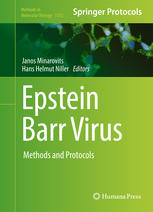

Most ebook files are in PDF format, so you can easily read them using various software such as Foxit Reader or directly on the Google Chrome browser.
Some ebook files are released by publishers in other formats such as .awz, .mobi, .epub, .fb2, etc. You may need to install specific software to read these formats on mobile/PC, such as Calibre.
Please read the tutorial at this link: https://ebookbell.com/faq
We offer FREE conversion to the popular formats you request; however, this may take some time. Therefore, right after payment, please email us, and we will try to provide the service as quickly as possible.
For some exceptional file formats or broken links (if any), please refrain from opening any disputes. Instead, email us first, and we will try to assist within a maximum of 6 hours.
EbookBell Team

4.0
86 reviewsThis volume explores data from the applications of molecular biological methods and the applications of recent immunological and cytogenetic methods in Epstein-Barr Virus (EBV) that will offer readers possible new solutions to the unresolved problems in the EBV field. Chapters in this book cover topics such as: viral life cycle, latency, EBV-associated diseases and EBV diagnostics; in vitro methods including organotypic cultures for the analysis of EBV-epithelial cell interactions; identification of the interacting viral and cellular proteins using affinity purification-mass spectrometry methods; 3D telomere FISH; transcription analysis using high-throughput RNA sequencing, qPCR and nuclear run-on assay; analysis of viral and cellular microRNAs; isolation and characterization of exosomes and the assessment of their function; characterization of the viral genome by terminal repeat analysis and sequencing; the use of chromatin immunoprecipitation coupled sequencing (ChIP-Seq) for the analysis of Zta-DNA interactions; epigenetic analysis by bisulfite sequencing and ChIP; novel in vivo models for the study of EBV infection; and how immunological, virological, tissue culture and molecular methods can be combined to yield Good Manufacturing Practice-compliant EBV-specific T cells for the immunotherapy of EBV-associated post-transplant lymphoproliferative diseases (PTLD). Written in the highly successful Methods in Molecular Biology series format, chapters include introductions to their respective topics, lists of the necessary materials and reagents, step-by-step, readily reproducible laboratory protocols, and tips on troubleshooting and avoiding known pitfalls.
Cutting-edge and comprehensive, Epstein Barr-Virus: Methods and Protocols is a valuable resource for anyone who is interested in this fascinating and evolving field.